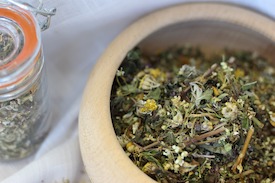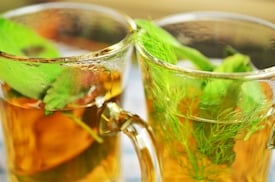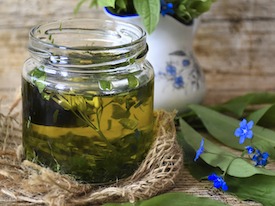10
20

Phytotherapie - Spagyrik - Homöopathie
In dieser Serie wollen wir Ihnen Informationen über verschiedene traditionelle Heilverfahren liefern und Unterschiede und Wirkungsweisen aufzeigen.
Die Entstehung der Heilpflanzenkunde
Der erste Teil beschäftigt sich mit der Phytotherapie. „Phyto“ stammt von dem grieschichen Wort „phyton“ ab und bedeutet zunächst nichts anderes als „Pflanze“. Phyto-Therapie ist somit also ein Umgang mit Pflanzen. Im engeren Sinn ist natürlich die Therapie mit Heilpflanzen gemeint. Doch wir werden uns genauer ansehen, ob es sich nur um eine Therapieform handelt, oder ob Pflanzen nicht auch ein Teil eines bestimmten Lebensstils sein können.
Wie lange es die Phytotherapie oder Heilpflanzenkunde bereits gibt, wird vermutlich nie abschließend geklärt werden können. Salopp gesagt gibt es sie aber vermutlich seit Beginn der Menschheit, wobei auch dieser Gedanke schon unzureichend ist, da es Beobachtungen bei Tieren gibt, die ebenso bei verschiedenen Erkrankungen bestimmte Pflanzen oder Pflanzenteile aufsuchen und fressen.
Eines der ältesten Dokumente der Medizingeschichte ist das „Papyrus Ebers“, das im alten Ägypten gefunden wurde und meistens auf das letzte Viertel des 16. Jahrunderts vor Christus datiert wird. Vermutlich ist es sogar einige Jahrzehnte älter. 1
Die ältesten, heute noch weit bekannten Autoren waren sicherlich Hippokrates von Kos (460-370 v. Chr.) und Galen von Pergamon (ca. 130-200 n.C hr.). Von Hippokrates soll der Spruch (sinngemäß) stammen, dass die Nahrungsmittel die Heilmittel seien und die Heilmittel die Nahrungsmittel.
Heute erlebt man jedoch, dass getrunken und geschlemmt wird nach Gutdünken, und wenn man krank wird, bekommt man „Schonkost“ verordnet. Hierfür gibt es keine einheitliche, medizinische Definition, aber man liest bei Wikipedia: „Eine andere Definition betrachtet die allgemeine Schonkost als biologisch vollwertige Kost in leicht verdaulicher Form.“ 2
Bevor das Feuer in das Leben der Menschen Einzug gehalten hat, waren tierische Lebensmittel eher unbedeutend. Erst durch das Grillen, Räuchern und später auch andere Verfahren zur Haltbarmachung wurden Tiere als Nahrungsmittel interessant und somit hat sich die Menschheit in der ersten Zeit wohl ausschließlich von Pflanzen ernährt. Zunächst Früchte, Blätter, Nüsse und Samen, später auch Wurzeln, die ausgegraben wurden. Im späteren Verlauf wurden Pflanzen gezielter eingesetzt, weil man gemerkt hat, dass von ihnen spezifische Wirkungen ausgingen. Aus dieser Entwicklung ergab sich dann die Heilpflanzenkunde, die heute grob in Erfahrungsheilkunde und rationale Phytotherapie eingeteilt werden kann.
Apropos Erfahrungsheilkunde; Es wird ja immer wieder so dargestellt, dass die Heilpflanzenkunde früher mehr oder minder nur nach dem so genannten „Try-and-error“-Prinzip funktioniert hätte. Frei nach dem Motto: „Hier, trink mal diesen Tee“.... „O, das Kraut war wohl giftig.“
Interessanterweise scheint dem aber ganz und gar nicht so gewesen zu sein. Es gibt eine Disziplin, die in den letzten Jahrzehnten wieder eine Renaissance erlebt: Die Signaturenlehre. Hier geht man davon aus, dass jede Pflanze durch ihren Standort, ihr Wuchsverhalten, Blüten, Blätter, Farbe, Geruch, Geschmack usw. sehr genau kommuniziert, wo und wie sie wirkt – wenn man die Sprache der Pflanze versteht. Gerade im 16. Jahrhundert sind einige große Kräuterwerke von Leonhart Fuchs, Tabernaemontanus und anderen erschienen, die den Wissensstand der damaligen Heilpflanzenkunde umfassend darstellten. Die moderne Labortechnik und so genannte evidenzbasierte Medizin hat in den letzten 50 bis 100 Jahren nicht viel nennenswertes Neues herausgefunden. Einige Indikationen, also Anwendungsgebiete, der damals Beschriebenen sind entfernt worden, aber letztlich wurden über 80 Prozent des damaligen Wissens durch klinische Studien im Grunde bestätigt.
Varianten der Kräuterheilkunde
Sicher haben Sie schon einmal von der Klostermedizin gehört. Es ist nicht wirklich eine eigene Form der Kräuterheilkunde, sie wurde durch die Klöster aber auf ein neues Niveau gehoben. Immerhin reden wir hier über eine Zeit, in der die meisten Menschen weder lesen noch schreiben konnten und das meiste Wissen mündlich überliefert wurde. Wenn man nun bedenkt, dass zum Beispiel in den Klöstern, Burgen und Schlössern eher Wein und Bier als Wasser getrunken wurde, da dieses durch Verunreinigungen unschöne Magen-Darm-Infektionen auslöste, dann kann man sich vorstellen, dass die Wissensweitergabe mitunter – sagen wir mal – etwas lückenhaft war. Interessant zu wissen: Bei einer Führung in der Reichsburg Cochem wird man gewarnt, dass Frauen damals bis zu drei Liter Bier und Männer bis zu fünf Liter Bier pro Tag (!) zu trinken bekamen. Die Klöster waren die Zentren der Gelehrten und zeitgleich wurden hier oder von hier aus zahlreiche Kranke behandelt. In den klostereigenen Gärten (wie man sie heute noch beispielsweise in Fulda und Andechs erfahren kann) wurden Gemüse und Kräuter für die Nahrungsmittelversorgung ebenso angebaut wie die Heilpflanzen für die Versorgung von Patienten. Aus den Klöstern existieren auch interessante Dokumente bezüglich Fruchtfolgen und Anbaumethoden, die sich bewährt haben.
Zeitgeschichtlich umfasst die „Klostermedizin“ eine Zeitepoche von etwa dem 8. bis 12. Jahrhundert n. Chr. Der Ursprung geht auf die „Regula benedicti“ des heiligen Benedikt von Nursia zurück, dem Begründer des Benediktinerordens. In Kapitel 36 legte er fest, dass jedes Kloster über eine Krankenstation und einen geschulten Pfleger verfügen sollte. Papst Gregor I. erklärte diese Regularien als Vorbild für die Klöster der katholischen Kirche.
Als König und Kaiser Karl der Große (747 – 814 n. Chr.) sein Reich nach dem Vorbild des römischen Imperiums reformieren wollte, übertrug er den Klöstern unter anderem auch die Aufgabe der medizinischen Versorgung. Eine der größten beziehungsweise bekanntesten Veröffentlichungen der Klostermedizin ist das Lorscher Arzneibuch, das um 790 n. Chr. geschrieben wurde. Dort war der Fenchel die am häufigsten genannte Pflanze, aber auch Gewürze wie Ingwer und Pfeffer oder Harze wie Myrrhe und Weihrauch wurden oft genannt. Ein weiteres wichtiges Dokument war der St. Galler Klosterplan, der quasi als Blaupause eines idealen Klosters diente. Im oberen Teil war ein ganzer Krankentrakt mit Spital, Arzthaus und Kräutergarten vorgesehen und wo die Schwerstkranken im Haus des Möncharztes untergebracht waren, damit er sich umgehend um sie kümmern konnte.
Ein weiterer eigener Weg war die so genannte „Hildegard-Heilkunde“. Hildegard von Bingen stellt in der Tat einen Sonderfall in der Medizingeschichte dar. Durch arge Migräneattacken geplagt, bekam sie viele Visionen, die sie sich vom Papst persönlich als „von göttlicher Natur“ bestätigen ließ. Sie hinterließ einige Rezepte, die der damaligen Klostermedizin fremd waren und maßgeblich durch Dr. Herzka und Strehlow weiter erforscht, angewandt und publiziert wurden.
Eine neue Form der Heilpflanzenkunde ist die „rationale Phytotherapie“, die - wie viele Neuerungen - Fluch und Segen zugleich ist.
Diese Therapieform erhebt den Anspruch, die Heilpflanzenkunde nach wissenschaftlichen Kriterien anzuwenden, so dass in den Rezepturen nur Pflanzen vorkommen, die von der Kommission E eine „Positiv-Monografie“ erhalten haben, also durch Studien oder ausreichende Dokumentation eine nachweisliche Wirkung bei einer bestimmten Indikation haben. Der Segen liegt darin, dass hier Wissen vorangetrieben und die Zuverlässigkeit pflanzlicher Arzneimittel belegt werden konnte. Und so haben es verschiedene pflanzliche Fertigarzneimittel sogar bis in die Leitlinien bei verschiedenen Erkrankungen geschafft ( zum Beispiel Myrrhe-Kamille-Kaffeekohle-Arznei bei chronisch entzündlichen Darmerkrankungen und Meerrettich-Kapuzinerkresse-Arznei bei unkomplizierten Harnwegsinfekten).
Der Fluch liegt leider darin, dass Erfahrungsschätze verloren gehen. In der traditionellen Heilpflanzenkunde gab es schon immer so genannte „Vermittlerpflanzen“, die zwar selbst nicht gegen die Indikation (z.B. Husten) halfen, aber die Gesamtwirksamkeit durch noch nicht ganz geklärte Faktoren erhöhten. Hier liegen zum Beispiel bei der Süßholzwurzel spannende Untersuchungen dazu vor, wie verschiedene Rezepturen nach Zugabe von Süßholz bessere Ergebnisse erzielten, obwohl Süßholz für die verwendeten Indikationen gar keine direkte Wirkung zeigte.
Verschiedene Zubereitungsformen
Was kann man den nun mit Heilpflanzen machen?
Die einfachste und ehrlichste Form ist immer, sie zu essen - unter Vorsicht natürlich, wenn man nicht weiß, ob die Pflanze giftig ist oder nicht! Hier spürt man schnell, ob es sich um eine bittere Pflanze handelt (zum Beispiel Wermutstrauch), eine adstringierende (unter anderem Blutwurz), eine ätherische (wie Lavendel und Melisse) oder um eine krautige (zum Beispiel Gänsefingerkraut). Gerade die „Unkräuter“ erleben sogar in der Spitzengastronomie eine nicht geahnte Renaissance. Schafgarbe, Spitzwegerich und Co. werden von Sterneköchen ganz neu entdeckt, was sicherlich ein guter Trend ist, diese wertvollen Pflanzen und Geschmäcker wieder in die tägliche Ernährung einzubauen.

Trocknet man seine Kräuter aus dem Garten an einem trockenen, luftigen Ort, so kann man den ganzen Winter von seinem Garten zehren. Aber Vorsicht! Wenn man Tee aus getrockneten Kräutern zu sich nimmt, konsumiert man Drogen! Jawohl. Allerdings braucht man sich hier keine Gedanken über rechtliche Konsequenzen zu machen. In der Tat stammt das Wort „Droge“ aus der pharmazeutischen Welt und heißt „dröge“, was nichts anderes bedeutet als „trocken“. 😉

Die nächsten Zubereitungsformen wären der Infus und der Dekokt. Infus ist das, was wir als Teezubereitung kennen. Eine bestimmte Menge frisches oder getrocknetes Kraut wird in der Regel mit heißem Wasser übergossen, ein paar Minuten ziehen gelassen, abgeseiht und dann getrunken. Eine Sonderform wäre hier der Kaltauszug, wie man ihn bei Schleimdrogen, dazu gehören unter anderem Eibisch und Malve, gerne anwendet oder bei der Mistel. Hierbei wird über Nacht das Kraut in kaltem Wasser angesetzt, abgeseiht und dann vor dem Trinken etwas erwärmt.
Letztlich gibt es noch den Dekokt, eine Abkochung. Hierbei werden die Kräuter, zum Beispiel Schachtelhalm oder Eichenrinde, über mehrere Minuten ausgekocht.
Da es einige Inhaltsstoffe gibt, die sich in Wasser nicht lösen lassen, gibt es die alkoholischen Tinkturen. Hierbei werden Heilpflanzen einzeln, oder bereits als Rezeptur in Alkohol ausgezogen, wie zum Beispiel auch bei der Bärlauch-Essenz und bei der Cilantro-Essenz. (Sonderformen lernen wir noch bei der Spagyrik kennen). Für den Hausgebrauch hat sich statt des medizinischen Alkohols Wodka, Doppelkorn oder Grappa bewährt. Der Alkoholgehalt sollte etwa um die 40 Vol% betragen. Von einer Tinktur werden meistens 3 x 10 bis 3 x 30 Tropfen, verdünnt in Wasser eingenommen, als Mundspüllösung verwendet oder auch zur äußerlichen Anwendung benutzt, wie man es vom Franz-Branntwein kennt.

Eine weitere klassische Möglichkeit, Pflanzen zu verarbeiten, ist der Ölauszug. Hierbei werden die Pflanzen, wie beispielsweise Johanniskraut, für ein bis drei Tage etwas angetrocknet und dann in ein Basisöl gegeben. Das leichte Antrocknen verhindert eine Schimmelbildung an der Oberfläche. Nach etwa drei Wochen ist das Öl, je nach Inhalt kühl und dunkel oder hell und sonnig gereift, einsatzbereit. Ölauszüge können innerlich und äußerlich angewendet werden oder auch zur Mundpflege.
Eine sehr schöne, aber leider nicht mehr weit verbreitete Anwendungsform ist das Räuchern. Hierbei werden getrocknete Pflanzenanteile auf eine Räucherkohle aufgelegt und verräuchert. Eine einfache und schöne Form, sein Haus zu reinigen. Ein mit Lavendel geräuchertes Haus trägt auch noch nach einer Woche einen subtilen Lavendelgeruch in der Luft. Natürlich können auch fertige Räucherstäbchen oder -kegel benutzt werden. Hierbei sollte man aber auf eine hohe Reinheit achten und keine Produkte mit künstlichen Duftstoffen erwerben.
Wenn wir schon beim Geruch sind, gibt es auch die spannende Welt der ätherischen Öle zu entdecken, zu denen wir einen separaten Exkurs machen werden. Soviel sei schon mal verraten: Ätherische Öle, also nicht billige Duft- und Parfüm-Öle) können mehr, als nur den Raum gut riechen lassen.
Andere Zubereitungsformen wie das Pulverisieren oder Tablettieren sind für den Hausgebrauch wenig geeignet und den Herstellern von Medikamenten und Nahrungsergänzungen vorbehalten.
Nutzen und Wirkung von Heilpflanzen
Abschließend kommen wir noch zu der Wirkung von Heilpflanzen. Da wir im Weiteren auch andere Möglichkeiten der Pflanzenzubereitungen anschauen wollen, macht es Sinn, die verschiedenen Wirkwege voneinander abzugrenzen.
Im Bereich der rationalen Phytotherapie wurde es schon am Rande angedeutet. Die klassischen Heilpflanzenzubereitungen, vor allem Tabletten, Kapseln und alkoholische Tinkturen, wirken hauptsächlich durch ihre Inhaltsstoffe. Sie sind im Grunde genommen – ähnlich wie bei der Schulmedizin – ein chemisches Verfahren. Schließlich basieren auch bekannte Medikamente wie Aspirin, Digitoxin und andere auf pflanzlichen Wirkstoffen. Der „Ideengeber“ von Aspirin ist die Weidenrinde mit ihren Salicylsäuren, während der rote Fingerhut mit seinem herzstärkenden Gift der Substanzlieferant vom Digitoxin war. Da bei diesen Pflanzen ein bestimmter Wirkstoff ausfindig gemacht werden konnte, der für die Wirkung verantwortlich ist (bei Johanniskraut hat man das nie geschafft, wie Sie bereits erfahren haben), wurden diese dann aus Aufwands- und Kostengründen chemisch synthetisiert.
Ob die chemisch-synthetischen Varianten aus Ganzheitssicht wirklich besser sind, wäre auch noch eine Diskussion wert, da bei reinem Digitoxin die Vergiftungserscheinungen viel früher eintraten als bei der gleichen Menge an Digitoxin aus einem Gesamtpflanzen-Extrakt. Auch ist Aspirin (ASS) für seine magenschädigende Wirkung bekannt und deshalb bei der Prophylaxe von Schlaganfällen nicht ganz unumstritten, während die Auszüge aus Weidenrinde erst am Ort der Entzündung in Acetylsalicylsäure umgewandelt werden und noch nicht im Magen wirksam werden.
Fazit
Letztlich sind Heilpflanzen mit ein wenig Laienwissen ein guter Einstieg für die eigene Küche und Hausapotheke. Es gibt gute Bücher, in die man sich einlesen kann oder sehr gute Kurse für Laien oder medizinisch versiertere Menschen beispielsweise an der Phytaro Heilpflanzenschule in Dortmund.
Zu Beginn hieß es, dass Heilpflanzen vielleicht neben der rein therapeutischen Anwendung auch ein Teil eines bestimmten Lebensstils sein können. Indem man sich bewusst für eine pflanzenbasierte Ernährung entscheidet, indem man vielleicht auf dem Balkon, im Hochbeet eigene Salate und Gemüse anbaut, indem man Blumen im Haus hat und sich gelegentlich schöne Sträuße ins Wohnzimmer und auf den Esstisch stellt, Blühwiesen an ungenutzten Stellen des Grundstücks aussäht, sich Blumenkränze für die Haare bindet, räuchert oder sich öfter in den Wald zu den Bäumen zurückzieht und die Natur auf sich wirken lässt – sich also intensiv mit Pflanzen beschäftigt und sich mit ihnen umgibt, der wird merken, dass Pflanzen mehr sind, als chemische Gemische, die man verschiedentlich pharmazeutisch zubereiten und anwenden kann. Falls die Männer gerade nicht wissen, wovon hier die Rede ist: Kaufen Sie Ihrer Liebsten einfach mal einen schönen Strauß Blumen und schauen Sie ihr beim Überreichen einmal aufmerksam ins Gesicht und in die Augen!
Empfehlung der Redaktion
Author:in

















